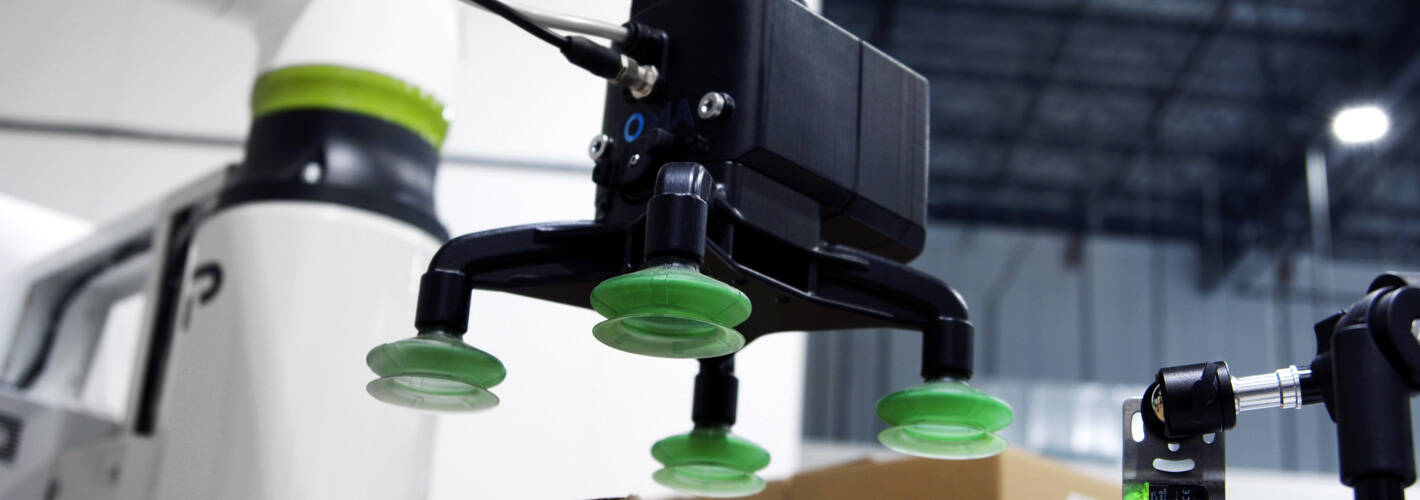
How to integrate a cobot palletizer: A step-by-step guide

You’ve probably heard the buzz about the benefits of cobot palletizers, but did you also know that they can be very simple to integrate?
Check out this short guide on how integrate a cobot palletizer for any business.
Integrating automation into your manufacturing process is a surefire way to improve efficiency and reduce costs. One area where businesses often see significant benefits is palletizing. Traditional palletizing is a repetitive and physically demanding task, but with a collaborative palletizing robot, you can streamline the process while ensuring both safety and precision.
In this 5-step guide, we'll show you how to seamlessly integrate a cobot palletizer into your operations.
But first, let’s do a quick recap on the benefits of choosing a cobot palletizer.
Palletizing cobots at a glance
A palletizing cobot is a collaborative robot specifically designed to stack products, boxes, or packages onto pallets. The key word here is "collaborative." These robots are built with advanced safety features that make it safe for human workers to share the same workspace. They can also be easily reconfigured to handle different sizes and shapes of products.
Traditional palletizing robots, in contrast, are industrial robots that must operate within secured, fenced-off areas. They're typically larger, faster, and can handle heavier loads, but they require complete isolation from human workers for safety reasons. Often, they are only designed to handle one job.
Here are some other key benefits of palletizing robots, and the main attractions for forward-thinking companies:
- Productive: Cobots fill labor gaps by taking over the repetitive task of palletizing and ensure consistent production.
- Flexible: Cobots are designed to be reconfigured quickly for different packaging sizes and set-ups, allowing for increased agility and ability to respond to changing demands.
- Cost-effective: Cobots generally have a low upfront cost with a fast ROI.
So, how do you integrate this type of automation into your existing workflow and gain access to all these benefits?
Step-by-step guide to integrating a palletizing cobot
Integrating a collaborative robot palletizer into your set-up will require consideration of your specific needs and constraints. But the good news is that your operations likely won’t need a complete overhaul: adding a palletizing cobot to your set-up is actually a simple entry point to automation. Here are the five basic steps.
1. Identify your palletizing requirements
First, assess your current palletizing workflow – daily box count, pallet patterns, and product sizes and weights.
You will also want to consider your space constraints and existing pallet handling systems.
Example: For a food industry project which required palletizing 2,000 to 3,000 boxes daily, Groupe TAQ adopted the TOMA™ palletizer to offer not only safety but increased overall throughput.
2. Choose the right palletizing cobot
Pick a cobot that fits your needs in terms of size and load capacity.
The best cobot solutions require no robotics expertise and are designed to be simple and intuitive. Look for intuitive programming interfaces for pattern creation and adjustment.
Example: The TOMA™ palletizer is a flexible, highly intuitive piece of equipment that features cobot technology and is designed to be seamlessly integrated into various industries.
3. Plan your installation
Assess the layout of your warehouse for optimal pallet and product flow and choose appropriate end-of-arm tooling (vacuum or gripper) for your products.
Ensure proper integration with conveyors, pallet dispensers, and wrapping systems.
Example: A strong service provider will be a company with proven experience in collaborative robotics and palletizing workflows.
4. Train your team
Provide basic training for employees to work alongside the cobots, focusing on safety and handling procedures.
Example: Boulangerie Dumas successfully trained operators to manage pattern changes and maintain efficient palletizing operations in their manufacturing facility.
5. Optimize your palletizing process
Monitor key metrics.
Fine-tune motion paths and speeds for maximum efficiency.
Document successful pallet patterns for quick changeovers.
Example: Some cobot equipment comes with integrated technology like Necton™, which provides easy, actionable snapshots of insights you can act on quickly.
Palletizing with collaborative robots: The next right step
Integrating palletizing cobots into your operations is a strategic move that can significantly boost efficiency, safety, and flexibility. By automating your palletizing work with a cobot, you can free up your workforce to focus on higher-value activities.
With the right cobot solution, integration is simple and your business can quickly incorporate and respond to growing needs. The future of manufacturing is collaborative—embrace cobots, expand your production lines and take your operations to the next level.
Interested in using a cobot for your palletizing needs?
Premier Tech’s latest offering, TOMA™, combines 35 years of experience in palletizing with the power of cobot technology. Head over to our TOMA™ Palletizer page to learn more.
